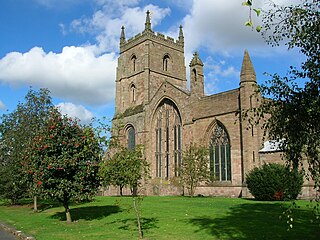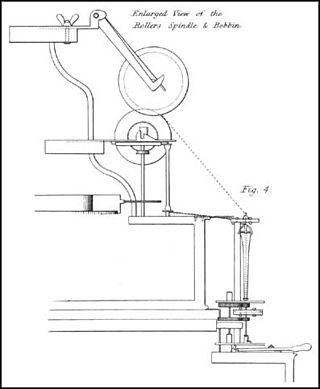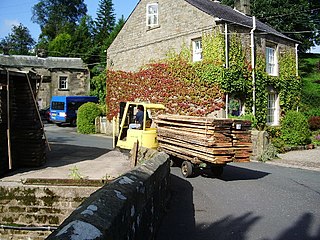
Carding is a mechanical process that disentangles, cleans and intermixes fibres to produce a continuous web or sliver suitable for subsequent processing. This is achieved by passing the fibres between differentially moving surfaces covered with "card clothing", a firm flexible material embedded with metal pins. It breaks up locks and unorganised clumps of fibre and then aligns the individual fibres to be parallel with each other. In preparing wool fibre for spinning, carding is the step that comes after teasing.

Sir Richard Arkwright was an English inventor and a leading entrepreneur during the early Industrial Revolution. He is credited as the driving force behind the development of the spinning frame, known as the water frame after it was adapted to use water power; and he patented a rotary carding engine to convert raw cotton to 'cotton lap' prior to spinning. He was the first to develop factories housing both mechanised carding and spinning operations.

Leominster is a market town in Herefordshire, England; it is located at the confluence of the River Lugg and its tributary the River Kenwater. The town is 12 miles north of Hereford and 7 miles south of Ludlow in Shropshire. With a population of 11,700, Leominster is the largest of the five towns in the county; the others being Ross-on-Wye, Ledbury, Bromyard and Kington.

A cotton mill is a building that houses spinning or weaving machinery for the production of yarn or cloth from cotton, an important product during the Industrial Revolution in the development of the factory system.

Textile manufacture during the British Industrial Revolution was centred in south Lancashire and the towns on both sides of the Pennines in the United Kingdom. The main drivers of the Industrial Revolution were textile manufacturing, iron founding, steam power, oil drilling, the discovery of electricity and its many industrial applications, the telegraph and many others. Railroads, steamboats, the telegraph and other innovations massively increased worker productivity and raised standards of living by greatly reducing time spent during travel, transportation and communications.
Birmingham is one of England's principal industrial centres and has a history of industrial and scientific innovation. It was once known as 'city of a thousand trades' and in 1791, Arthur Young described Birmingham as "the first manufacturing town in the world". Right up until the mid-19th century Birmingham was regarded as the prime industrial urban town in Britain and perhaps the world, the town's rivals were more specific in their trade bases. Mills and foundries across the world were helped along by the advances in steam power and engineering that were taking place in the city. The town offered a vast array of industries and was the world's leading manufacturer of metal ware, although this was by no means the only trade flourishing in the town.
John Kay was an English inventor best known for the development of the spinning frame in 1767, which marked an important stage in the development of textile manufacturing during the Industrial Revolution. Born in Warrington in Lancashire, England, Kay was at least the co-constructor of the first spinning frame, and was a claimant to having been its inventor. He is sometimes confused with the unrelated John Kay from Bury, Lancashire, who had invented the flying shuttle, a weaving machine, some thirty years earlier.

Cotton-spinning machinery is machines which process prepared cotton roving into workable yarn or thread. Such machinery can be dated back centuries. During the 18th and 19th centuries, as part of the Industrial Revolution cotton-spinning machinery was developed to bring mass production to the cotton industry. Cotton spinning machinery was installed in large factories, commonly known as cotton mills.

Thomas Highs (1718–1803), of Leigh, Lancashire, was a reed-maker and manufacturer of cotton carding and spinning engines in the 1780s, during the Industrial Revolution. He is known for claiming patents on a spinning jenny, a carding machine and the throstle.
John Wyatt, an English inventor, was born near Lichfield and was related to Sarah Ford, Doctor Johnson's mother. A carpenter by trade he began work in Birmingham on the development of a spinning machine. In 1733 he was working in the mill at New Forge (Powells) Pool, Sutton Coldfield attempting to spin the first cotton thread ever spun by mechanical means.

Lewis Paul was the original inventor of roller spinning, the basis of the water frame for spinning cotton in a cotton mill.
Thomas Warren was an English bookseller, printer, publisher and businessman.
The Upper Priory Cotton Mill, opened in Birmingham, England in the summer of 1741, was the world's first mechanised cotton-spinning factory or cotton mill. Established by Lewis Paul and John Wyatt in a former warehouse in the Upper Priory, near Paul's house in Old Square, it was the first of the Paul-Wyatt cotton mills that used the roller spinning machinery that they had developed and that had been patented by Paul in 1738, that for the first time enabled the spinning of cotton "without the aid of human fingers". Wyatt had realised that this machinery would enable several machines to be powered from a single source of power: foreseeing the development of the factory system, he envisaged "a kind of mill, with wheels turned either by horses, water or wind."

Marvel's Mill on the River Nene in Northampton, England, was the world's second factory for spinning cotton, the first to be operated as a water mill, and the first to be driven by an inanimate power-source. Opened by Edward Cave in 1742, it was one of the Paul-Wyatt cotton mills that used the roller spinning machinery invented by Lewis Paul and John Wyatt, which had first been used in their Upper Priory Cotton Mill in Birmingham in the summer of 1741.
Daniel Bourn was an English inventor, who took out a patent for a carding machine with rotating cylinders in 1748.

Kirk Mill is an early example of an Arkwright-type cotton mill and a grade II listed building in Chipping, Lancashire. Built in the 1780s on the site of a corn mill dating back to at least 1544, it operated as a cotton mill with water frames and then throstles until 1886 when it was sold and repurposed as H.J. Berry's chairmaking factory, powered by a 32 ft (9.8 m) waterwheel, which continued in use, generating electricity until the 1940s.
Thomas Yeoman was a millwright, surveyor and civil engineer who played a significant part in the early industrial revolution and became the first president of the first engineering society in the world, the Society of Civil Engineers, now known as the Smeatonian Society of Civil Engineers.
Pinsley Mill, also known as Etnam Street Mill, is a former watermill in Leominster, Herefordshire, England.
Samuel Touchet was an English cotton merchant, manufacturer and politician.
Peter Atherton was a British inventor, entrepreneur, and cotton mill proprietor. Renowned for his pioneering work as a designer and manufacturer of textile machinery during the early Industrial Revolution, Atherton began his career by assisting Richard Arkwright and John Kay in developing the ground-breaking spinning frame in the late 1760s. Subsequently, Atherton developed methods to elongate cotton, wool, and silk fibres, resulting in stronger, smoother yarn and finer quality fabrics, representing a notable progression in textile manufacturing. His influence extended to mill construction nationwide, where his innovative designs and use of steam power marked significant advancements in industrial architecture. He engaged with policymakers and advocated for the interests of the British textile industry, notably participating in a delegation that met with Prime Minister William Pitt the Younger in 1788 to safeguard domestic production against the encroachments of the East India Company. Additionally, he established and invested in numerous enterprises within both the textile and clock and watchmaking industries. One of his companies, Atherton & Co., became a leading manufacturer of cotton spinners, with locations in Warrington, Manchester, and Liverpool.











